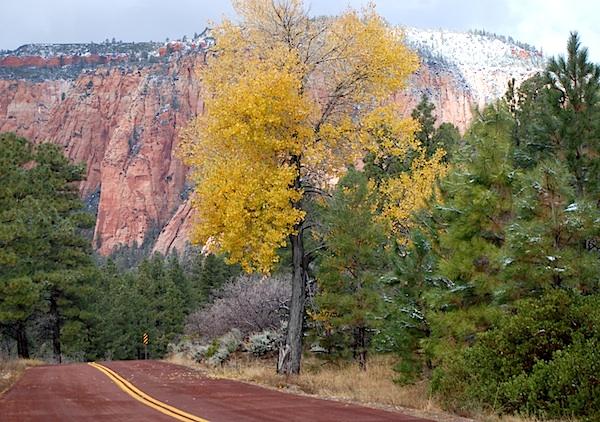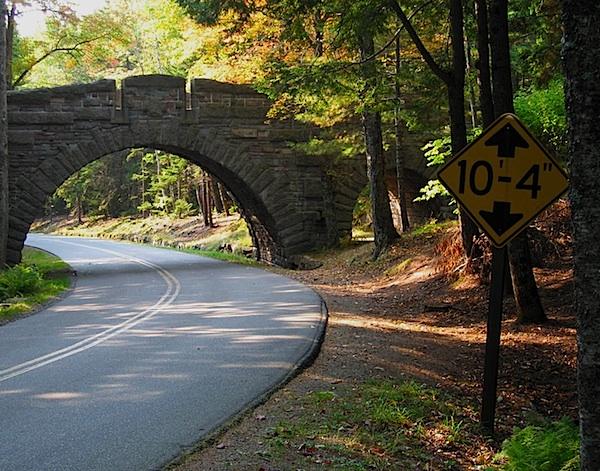
Before you head out for the first time onto national park roads, such as the Kolob Terrace Road in Zion National Park, with an RV, do a little research/Kurt Repanshek.
When planning a national park camping trip, many RVing newbies are surprised to learn that a stay in these public campgrounds is quite different from the usual RV park experience. From 1950s-era campgrounds with short parking aprons that are unsuitable for modern RVs, to strict generator use hours, the learning curve can be steep for inexperienced RVers. If you're a new RV traveler and considering a national park campground visit, here are five simple ways to have a great RV camping experience.
1. Research Your Route to the Park
Many national park campgrounds like Cedar Breaks National Monument in Utah are located in stunning, scenic locations reached only via steep, winding roads. To prepare for any unusual driving conditions like steep grades or gravel roads, check the 'Things to Know Before You Come' section of the park's website before you head out. Another tool that will help safely guide you to parks located in mountainous regions is the Mountain Directory Travel Guide, which provides the locations and descriptions of more than 700 mountain passes and steep grades in the United States. Finally, consider purchasing a GPS for RVs like the Magellan Road Mate RV, which allows you to navigate your route based on your vehicle's profile and driving preferences including avoiding unpaved roads, no U-turns and more.
2. Know the Size of Your RV
Once you're in the park it's not unusual to suddenly find yourself attempting to back into a parking space that's too short or narrow for your rig. To avoid this stressful scenario, know the exact height and length of your RV: take a bumper-to-bumper measurement (including any towed vehicles and utility trailers) of the length and height (remember to include air conditioning units and other rooftop objects like vents), then factor in the width (including all slide-outs).

Know the size of your rig before you go under a bridge, such as the Rockefeller Bridge at Acadia National Park, or into a tunnel/Rene Agredano
3. Understand Campground Accommodations and Limitations
Many of our national park campgrounds were designed around beautiful, natural scenic features like rocks, trees and canyons. As a result, access can sometimes be impeded and force you to find other camping arrangements. Learn all you can about a national park campground's facilities by visiting the park's website and reviewing campground information in the 'Plan Your Visit' section. For parks with reservable campsites, the reservation agency Recreation.gov, shares many campsite details like parking space sizes and whether or not hookups are available. Next, consider the experiences of other RVers by joining RV discussion forums and posting questions in places like Escapees.com's 'Travel' topic. Finally, for the most accurate campground information including seasonal conditions, call the park headquarters.
4. Get Ready to Boondock
National park campgrounds enhance the park experience by allowing campers to become immersed in natural surroundings ' which means you won't often find common RV park features like full-hookups. As a result, you'll need to get acquainted with 'RV boondocking,' which means to camp off-grid. First, understand how your RV works when it isn't connected to utilities by knowing how much power your appliances consume, Then, know how many days you can camp without emptying your waste holding tanks. Once you're in your site, practice extreme water conservation and propane use; remember, the less you have to stand in line at the dump station or rely on your generator for power, the more time you have to enjoy your vacation.
5. Don't Rely on Generator Power
Many first-time RVers find it easy to rely on gas-guzzling generators for doing everything from powering a microwave to watching television, but just because you can doesn't mean it's a good idea. Oftentimes national park campgrounds allow generator use, but only during certain hours and rarely past sunset. In addition, your solar-powered campground neighbors and tenters don't appreciate the ongoing drone of a generator or its exhaust, so be a Good Sam and limit generator use to only the most essential uses, like recharging RV batteries at the end of the day.
For many campers, traveling with the comforts of home can be a great way to experience the great outdoors, but when you're new to RVing there's a lot to learn along the way. To make the most of your road trips, understand your RV inside and out, talk to other more experienced RVers and remember that getting closer to nature means unplugging and slowing down enough to see the many reasons why our parks exist in the first place.
Rene Agredano is a full-time RVer who lives and works from America's most scenic spots. Since 2007, she's been roaming America's backroads with her husband and three-legged dog, while chronicling their adventures at LiveWorkDream.com.



Comments
Another thing you might want to check into is age restrictions on the RV.
Don't worry about tunnels there huge tour buses go through we were just there no problem we had 40ft RV
In regards to the Magellan GPS, the only thing we DID like about it was that you could enter the exact measurements of your RV, we had just bought it before our last trip and we returned it as soon as we got home! It would tell us to turn the opposite direction that we knew we needed to go. And we located a place we needed to go back to the next day and marked the coordinates while we were there, then the next day it couldn't direct us to the site we marked. We wouldn't recommend this to anyone!
Thanks for this info. Do you have one now that you *could* recommend?
How large is too large? We travel with a 35 ft fiver.
Bonnie, I'm pretty sure that public parks, at least those in the NPS, don't impose age restritions. I've never run into any.
I personally don't but maybe someone else can recommend a unit.
Ekim, I can't be certain but in the majority of national park campgrounds, a 35' RV would be pushing the limits in most campgrounds. It's best to check the park's individual websites to be certain. Usually the information provided regarding size limitations is pretty accurate.